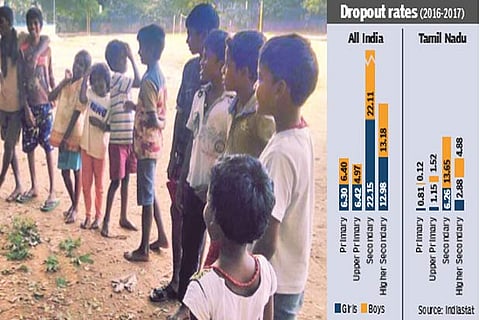

Chennai
Although the rates improved to 13.09 per cent at the higher secondary level, it is a cause for concern.
The draft National Education Policy (NEP) 2019, prepared by a panel chaired by Dr K Kasturirangan, former chairman of the Indian Space Research Organisation (ISRO), has taken note of the high dropout rates and makes many recommendations to contain it. The report cites several reasons for the high dropout rates, including, poor access, loss of interest in school, inadequate safety, particularly for girls and poor school infrastructure.
The Gross Enrollment Ratio (GER) at the primary level in 2016-17 was quite high, at 95.1 per cent, but went down to 90.7 per cent between grades 6-8, 79.3 per cent between grades 9-10 and further down to 51.3 per cent in Grades 11-12, according to the NEP.
Strengthening the foundation
The draft NEP suggests that school must be made interesting and learning more joyful. There will be close monitoring of the children. Counsellors and special educators will be attached to every school to offer emotional and remedial support to children dropping out because they have had inadequate qualitative input and find it impossible to catch up.
The best teachers will be assigned to regions that are seeing the highest dropout rates. There will be a continuous tracking of the child’s attendance, with community workers being in touch with the family to ascertain why a child is under performing or unable to cope.
Morning and mid-day meals will be provided to improve attendance and awards given to children who have a good attendance record.
Making schools accessible
According to the report, in 2016-2017 for every 100 primary schools, there are 50 upper primary schools, 20 secondary schools and only 9 higher secondary schools. As a corrective measure, the report recommends having more secondary and higher secondary schools, integrating primary and secondary schools in the area to make a composite school,accessible to all.
The issue of safety
In the case of girls, there is an additional dimension of safety, and families would generally prefer to keep young girls at home rather than have them depend upon public transport to travel long distances to school.
To address this, the report suggests a slew of measures including providing safe transport to students, providing safe hostels for students from remote locations, organised buses, organised walking groups, bicycles for older children or even some kind of transport allowance.
Providing safe hostels
The report suggests that the government set up a network of free hostels like the Navodaya schools and strengthen the Kasturba Gandhi Balika Vidyalayas to provide support to the girls from underprivileged backgrounds who cannot afford to stay outside home to pursue their education.
Health programmes
In regions where dropout are high owing to disease caused by poor hygiene, sanitation and poor nutrition, schools, social workers, counsellors, and/or health workers will work towards an awareness programme for parents and the community on health, hygiene and sanitation. Health workers will be attached to the schools.
Other socio-cultural issues such as early marriage, gender stereotypes and the necessity to be care-givers to younger siblings plus the pressure to be earning members also influence and impact a child’s schooling.
Second chance programmes
For dropout who desire an opportunity in later years, bridge courses will be provided to enable them to have a second chance at continuing education where they left off, or take up vocational training or skill development that will provide employment. Dropout over the age of 15 who have fallen way behind and cannot go back to school will have the option of taking adult literacy programmes.
Open Distance Learning (ODL) programmes offered through the National Institute of Open Schooling (NIOS) will be upgraded and expanded to cater to any child that cannot attend physical school. In addition to the Basic Learning course, it will offer education at A, B and C levels that correspond to Classes 3, 5 and 8, and secondary education corresponding to Classes 10 and 12. States will be encouraged to set up the States Institutes of Open Schooling (SIOS).
Broadbasing the RTE
The RTE will include secondary education so that by 2030 every child will enrol in school and complete class 12. Again the RTE will be made less restrictive to permit various types of schools to be set up, such as gurukuls, pathshalaas, madarasas and home schooling. However, there will be regulations with respect to physical and psychological safety of the child, access and inclusion, non-profit nature of schools and minimum standards forlearning outcomes.
Visit news.dtnext.in to explore our interactive epaper!
Download the DT Next app for more exciting features!
Click here for iOS
Click here for Android